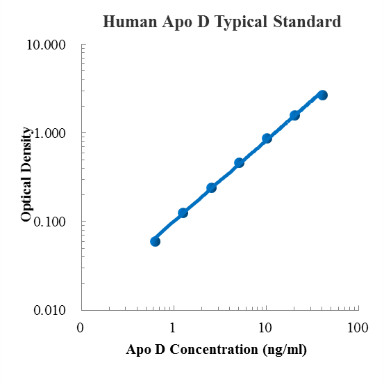
Human Apolipoprotein D/Apo D ELISA Kit
$350.00 – $450.00
| Sample Type | Serum, plasma, cell culture supernatant, and other biological samples |
|---|---|
| Sample Volume | 90 μL 1×Assay Buffer and 10 μL prediluted sample |
| Sensitivity | 25.67 pg/mL |
| Range | 0.63 ng/mL – 40 ng/mL |
| Assay Time | 3.5 h |
| Recovery | 85% – 103% |
| Average Recovery | 0.91 |
| Intra Precision | 2.0% – 8.1% |
| Inter-Precision | 1.9%-2.8% |
| Platform | ELISA |
| Plate | Detachable 96-well plate |
| Size | 96T/48T |
| Storage | If the reagent kit is unopened, it should be stored at 4℃. However, if it has been opened, the standard solution should be stored at -20℃, while the other components should be stored at 4℃. |
| Delivery | 4℃ blue ice transportation |
| Components | 96-well polystyrene enzyme-linked immunosorbent assay (ELISA) plate coated with anti-Apolipoprotein D/Apo D monoclonal antibody Human Apolipoprotein D/Apo D freeze-dried standard Apolipoprotein D/Apo D detect Antibody Standard Diluent Assay Buffer(10×) Substrate TMB Stop Solution Washing Buffer(20×) Sealing Film |
| Assay Principle | This kit utilizes the double antibody sandwich enzyme-linked immunosorbent assay (ELISA) detection technique.Specific anti-human Apo D antibodies are precoated on a high-affinity ELISA plate. Standard samples, test samples, and biotinylated detection antibodies are added to the wells of the ELISA plate. After incubation, Apo D present in the samples binds to the solid-phase antibodies and the detection antibodies. After washing to remove unbound substances, streptavidin-HRP labeled with horseradish peroxidase is added. After washing, a colorimetric substrate, TMB, is added and the plate is incubated in the dark for color development. The intensity of the color reaction is directly proportional to the concentration of Apo D in the samples.A stop solution is added to terminate the reaction, and the absorbance value is measured at a wavelength of 450 nm (with a reference wavelength range of 570-630 nm). |
Targets
APOD
APOD Target Infomation Overview
- Target Symbol: APOD, apolipoprotein D
- Gene Groups: Apolipoproteins; Lipocalins
- Alias: Apo-D
APOD, apolipoprotein D Target Infomation by Species
[su_tabs][su_tab title=”Human” disabled=”no” anchor=”” url=”” target=”blank” class=”tab-human”]
Human APOD Target Information
- Target Symbol: APOD, apolipoprotein D
- Alias:
- apo-D
- NCBI_Gene: 347
- UniProtKB: P05090
Human APOD Predicted Functions
Enables cholesterol binding activity. Involved in several processes, including negative regulation of cell-matrix adhesion; negative regulation of macromolecule metabolic process; and negative regulation of protein import into nucleus. Located in extracellular space and perinuclear region of cytoplasm. Implicated in obesity and type 2 diabetes mellitus. Biomarker of Alzheimer’s disease; gestational diabetes; and type 2 diabetes mellitus.
[/su_tab]
[su_tab title=”Mouse” disabled=”no” anchor=”” url=”” target=”blank” class=”tab-mouse”]
Mouse Apod Target Information
- Target Symbol: Apod, apolipoprotein D
- Alias:
- 无
- NCBI_Gene: 11815
Mouse Apod Predicted Functions
Predicted to enable cholesterol binding activity. Involved in negative regulation of lipoprotein lipid oxidation and response to reactive oxygen species. Predicted to be located in several cellular components, including cytosolic ribosome; neuronal cell body; and perinuclear region of cytoplasm. Predicted to be active in cytoplasm. Is expressed in several structures, including central nervous system; embryo mesenchyme; lip; sensory organ; and skeleton. Human ortholog(s) of this gene implicated in obesity and type 2 diabetes mellitus. Orthologous to human APOD (apolipoprotein D).
[/su_tab]
[su_tab title=”Rat” disabled=”no” anchor=”” url=”” target=”blank” class=”tab-rat”]
Rat Apod Target Information
- Target Symbol: Apod, apolipoprotein D
- Alias:
- AOPDGN
- apo-D
- NCBI_Gene: 25239
Rat Apod Predicted Functions
Predicted to enable cholesterol binding activity. Involved in several processes, including aging; nervous system development; and tissue regeneration. Located in several cellular components, including cytosolic ribosome; dendrite; and neuronal cell body. Biomarker of status epilepticus and vasculogenic impotence. Human ortholog(s) of this gene implicated in obesity and type 2 diabetes mellitus. Orthologous to human APOD (apolipoprotein D).
[/su_tab][/su_tabs]
APOD Target News
[catlist tags=”apod” template=targetnews thumbnail=yes thumbnail_class=”related-post-media clr” thumbnail_size=833]





